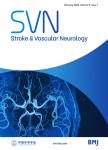Clinical features, treatment strategies and outcomes of craniocervical junction arteriovenous fistulas: a cohort study of 193 patients
作者机构:Department of Neurosurgery Xuanwu Hospital Capital Medical University
出 版 物:《Stroke & Vascular Neurology》 (卒中与血管神经病学(英文))
年 卷 期:2024年第9卷第1期
页 面:18-29页
核心收录:
基 金:National Natural Science Foundation of China Award Number:82101460.
主 题:patients treatment hypertensive
摘 要:Background Craniocervical junction(CCJ)arteriovenous fistulas(AVFs)are rare.The current treatment strategies for AVFs with different angioarchitecture need to be clarified.The present study aimed to analyse the correlation between angioarchitecture and clinical characteristics,share our experience in treating this disease and identify risk factors associated with subarachnoid haemorrhage(SAH)and poor outcomes.Methods A total of 198 consecutive patients with CCJ AVFs from our neurosurgical centre were retrospectively reviewed.The patients were grouped according to their clinical manifestations,and their baseline clinical characteristics,angioarchitecture,treatment strategies and outcomes were summarised.Results The patients’median age was 56 years(IQR 47–62 years).The majority of patients were men with 166(83.8%)patients.The most common clinical manifestation was SAH(52.0%),followed by venous hypertensive myelopathy(VHM)(45.5%).The most common CCJ AVFs type was dural AVF,with 132(63.5%)fistulas.The most frequent fistula location was C-1(68.7%)and dural branch of vertebral artery(70.2%)was the most involved arterial feeders for fistulas.The most common direction of venous drainage was descending intradural drainage(40.9%),followed by ascending intradural drainage(36.5%).Microsurgery was the most common treatment strategy applied for 151(76.3%)patients,15(7.6%)patients were treated with interventional embolisation only,and 27(13.6%)received both interventional embolisation and microsurgical treatment.The learning curve for microsurgery only was analysed by cumulative summation method,and the turning point was the 70th case,and blood loss in post-group was lower than that in pre-group(p=0.034).At the last follow-up,there were 155(78.3%)patients with favourable outcomes(modified Rankin Scale(mRS)3).Age≥56(OR 2.038,95%CI 1.039 to 3.998,p=0.038),VHM as the clinical manifestation(OR 4.102,95%CI 2.108 to 7.982,p0.001)and pretreatment mRS≥3(OR 3.127,95%CI 1.617 to 6.047,p0.001)were significantly associated with poor outcomes.Conclusion The arterial feeders and direction of the venous drainage were important factors in the clinical presentations.The location of fistula and drainage vein was essential for choosing different treatment strategies.Older age,VHM onset and poor pretreatment functional status predicted poor outcomes.



